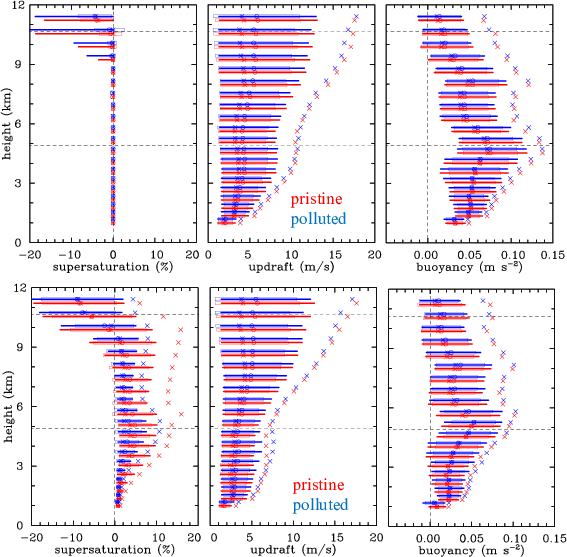Supersaturation and deep convection dynamics
Submitter
Grabowski, Wojciech — National Center for Atmospheric Research (NCAR)
Area of Research
Cloud Processes
Journal Reference
Grabowski W and H Morrison 2021. "Supersaturation, buoyancy, and deep convection dynamics." Atmospheric Chemistry and Physics, 21(18), 10.5194/acp-21-13997-2021.
Science

Figure 1. Statistics of supersaturation, vertical velocity, and buoyancy for deep convection simulations in grid volumes with updraft larger than 1 m s−1 and total condensate larger than 1 g kg−1. Upper panels: Data for the simulation assuming saturation adjustment and either pristine (red color) or polluted (blue color) CCN conditions. Lower panels: Similar data for simulations with supersaturation prediction. See Grabowski and Morrison (ACP 2021) for details. From journal.
Supersaturation, the excess of water vapor pressure over its saturated value, is a key parameter driving growth of cloud particles in deep convective updrafts. Supersaturation cannot be directly observed and its impact on cloud dynamics remains unclear. For numerical efficiency, cloud models often assume that the supersaturation inside convective updrafts vanishes, but the impact of such an assumption is uncertain.
Impact
By comparing model simulations with different microphysical schemes, either predicting the in-cloud supersaturation or assuming that it vanishes, the study explores the role of the finite supersaturation in deep convection dynamics. Finite supersaturations inside convective drafts have an appreciable impact on convective dynamics as illustrated by an analysis of simulated convective updraft strength, buoyancy, and supersaturation.
Summary
In an idealized framework, positive supersaturations noticeably reduce pseudo-adiabatic parcel buoyancy and cumulative convective available potential energy in the lower troposphere. This comes from keeping a small fraction of the water vapor in a supersaturated state and thus reducing the latent heating. Such a lower-tropospheric impact is comparable to the effects of condensate loading and entrainment in the idealized parcel framework. For the entire tropospheric depth, loading and entrainment have a much more significant impact. For the cloud model results, we compare ensemble simulations applying either a bulk microphysics scheme with saturation adjustment or a more comprehensive double-moment scheme with supersaturation prediction. Simulated deep convective updraft velocities, buoyancies, and supersaturations are compared. In agreement with the parcel analysis, the saturation-adjustment scheme provides noticeably stronger updrafts in the lower troposphere.
Keep up with the Atmospheric Observer
Updates on ARM news, events, and opportunities delivered to your inbox
ARM User Profile
ARM welcomes users from all institutions and nations. A free ARM user account is needed to access ARM data.


















